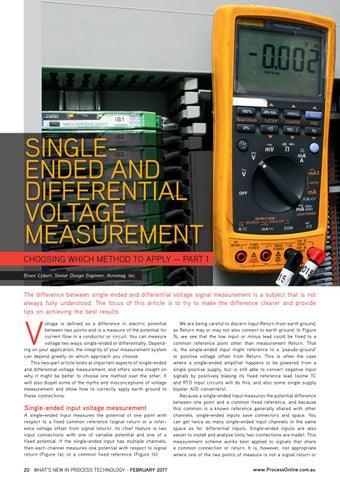SINGLEENDED AND DIFFERENTIAL VOLTAGE MEASUREMENT CHOOSING WHICH METHOD TO APPLY — PART 1 Bruce Cyburt, Senior Design Engineer, Acromag, Inc.
The difference between single-ended and differential voltage signal measurement is a subject that is not always fully understood. The focus of this article is to try to make the difference clearer and provide tips on achieving the best results.
V
oltage is defined as a difference in electric potential between two points and is a measure of the potential for current flow in a conductor or circuit. You can measure voltage two ways: single-ended or differentially. Depending on your application, the integrity of your measurement system can depend greatly on which approach you choose. This two-part article looks at important aspects of single-ended and differential voltage measurement, and offers some insight on why it might be better to choose one method over the other. It will also dispel some of the myths and misconceptions of voltage measurement and show how to correctly apply earth ground to these connections.
A single-ended input measures the potential of one point with respect to a fixed common reference (signal return or a reference voltage offset from signal return). Its chief feature is two input connections with one of variable potential and one of a fixed potential. If the single-ended input has multiple channels, then each channel measures one potential with respect to signal return (Figure 1a), or a common fixed reference (Figure 1b).
We are being careful to discern input Return from earth ground, as Return may or may not also connect to earth ground. In Figure 1b, we see that the low input or minus lead could be fixed to a common reference point other than measurement Return. That is, the single-ended input might reference to a ‘pseudo-ground’ or positive voltage offset from Return. This is often the case where a single-ended amplifier happens to be powered from a single positive supply, but is still able to convert negative input signals by positively biasing its fixed reference lead (some TC and RTD input circuits will do this, and also some single supply bipolar A/D converters). Because a single-ended input measures the potential difference between one point and a common fixed reference, and because this common is a known reference generally shared with other channels, single-ended inputs save connectors and space. You can get twice as many single-ended input channels in the same space as for differential inputs. Single-ended inputs are also easier to install and analyse (only two connections are made). This measurement scheme works best applied to signals that share a common connection or return. It is, however, not appropriate where one of the two points of measure is not a signal return or
20 WHAT'S NEW IN PROCESS TECHNOLOGY - FEBRUARY 2017
www.ProcessOnline.com.au
Single-ended input voltage measurement
